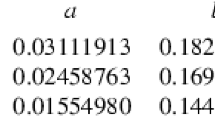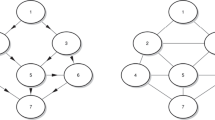Abstract
The Environmental Monitoring and Assessment Program (EMAP) of the U.S. Environmental Protection Agency has conducted several probability surveys of aquatic resources. Such surveys usually have unequal probability of including population elements in the sample. The Northeast lakes survey, which motivated this study of variance estimation, was such a survey. We examine ten estimators for the finite population variance using a Monte Carlo factorial experiment that considers three population characteristics. The results show that the correlation between the inclusion probabilities and the response is the most important factor that differentiates the estimators. Under conditions of low correlation (approximately <0.4), a common feature in environmental surveys, the sample variance is best, elsewhere, two ratio estimators, one based on consistency and the Horvitz-Thompson Theorem (HT) and the other based on the Yates-Grundy form, behave similarly and best.
Similar content being viewed by others
References
Akima, H. (1978), “A Method of Bivariate Interpolation and Smooth Surface Fitting for Irregularly Distributed Data Points,” ACM Transactions on Mathematical Software, 4, 148–159.
Brewer, K., and Hanif, M. (1983), Sampling With Unequal Probabilities, New York: Springer.
Cochran, W. G. (1977), Sampling Techniques (3rd Ed), New York: Wiley.
Dol, W., Steerneman, T., and Wansbeek, T. (1996), “Matrix Algebra and Sampling Theory: The Case of the Horvitz-Thompson Estimator,” Linear Algebra and its Applications, 237, 225–238.
Hartley, H., and Rao, J. (1962), “Sampling With Unequal Probability and Without Replacement,” Annals of Mathematical Statistics, 33, 350–374.
Hidiriglou, M., and Gray, G. (1980), “Construction of Joint Probability of Selection for Systematics p.p.s Sampling,” Applied Statistics, 29, 107–112.
Horvitz, D., and Thompson, D. (1952), “A Generalization of Sampling Without Replacement from a Finite Universe,” Journal of the American Statistical Association, 47, 663–685.
Larsen, D., and Christie, S. (1993), “EMAP-Surface Waters 1991 Pilot Report, Technical Report EPA/620/R-93/003,” Technical Report, U.S. Environmental Protection Agency Washington D.C.
Larsen, D., Thorton, K., Urquhart, N., and Paulsen, S. (1995), “The Role of Sample Surveys for Monitoring the Condition of the Nation’s Lakes,” Environmental Monitoring and Assessment, 32, 101–134.
Liu, T., and Thompson, M. (1983), “Properties of Estimators of Quadratic Finite Population Functions: The Batch Approach,” The Annals of Statistics, 11, 275–285.
McDonald, T. (1996), “Analysis of Finite Population Surveys: Sample Size and Testing Considerations,” Ph.D. thesis, Oregon State University.
Mitch, M., Kaufmann, P., Herlihy, A., Overton, W., and Sale, M. (1990), “National Stream Survey Database Guide. EPN600/8-90/055,” Technical Report, U.S. EPA Environmental Research Laboratory, Corvallis; Oregon.
Royall, R., and Cumberland, W. (1981), “An Empirical Study of the Ratio Estimator and Estimators of its Variance,” Journal of the American Statistical Association, 76, 66–88.
Särndal, C.-E., Swensson, B., and Wretman, J. (1992), Model Assisted Survey Sampling, New York: Springer-Verlag.
Stehman, S., and Overton, W. (1989), “Pairwise Inclusion Probability Formulas in Random-Order, Variable Probability, Systematic Sampling,” Technical Report 131, Oregon State University Department of Statistics, Oregon State University, Corvallis, OR.
— (1994a), “Comparison of Variance Estimators of the Horvitz-Thompson Estimator for Randomized Variable Probability Systematic Sampling,” Journal of the American Statistical Association, 89, 30–43.
— (1994b), “Environmental Sampling and Monitoring,” in Handbook of Statistics, eds. G. Patil and C. Rao, Amsterdam: Elsevier Science.
Stevens, D. (1994), “Variable Density Grid-Based Sampling Designs for Continuous Spatial Populations,” Environmetrics, 8, 167–195.
Thompson, S. K. (1992), Sampling, New York: Wiley.
Urquhart, N., Paulsen, S., and Larsen, D. (1998), “Monitoring for Policy-Relevant Regional Trends Over Time,” Ecological Applications, 8, 246–257.
Yates, F., and Grundy, P. (1953), “Selection Without Replacement from Within Strata with Probability Proportional to Size,” Journal of the Royal Statistical Society, Series B, 15, 253–261.
Author information
Authors and Affiliations
Corresponding author
Rights and permissions
About this article
Cite this article
Courbois, JY.P., Urquhart, N.S. Comparison of survey estimates of the finite population variance. JABES 9, 236–251 (2004). https://doi.org/10.1198/1085711043596
Received:
Revised:
Issue Date:
DOI: https://doi.org/10.1198/1085711043596




